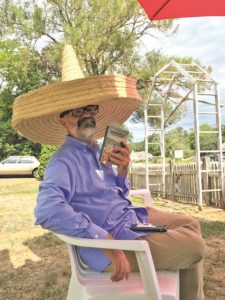“Did you see that guy’s sombrero?” incredulous drivers ask as they speed by Richard Pickering. “It’s huge!”
He has sat under an umbrella outside his family’s 1875 Wellfleet home on Route 6 across from Cumberland Farms, book or martini in hand, on most warm weekend days for over a decade.
“During stop-and-go traffic,” he says, “I’ve had conversations with people that almost always start with, ‘Sombrero Guy, can you bring me a martini, too?’ or ‘Hey, what are you reading?’ ”

In addition to the sombrero, which measures 26 inches across and 16 inches high, Pickering has worn many other hats, including scholar, actor, teacher, and now deputy director of the Plimoth Patuxet Museum (formerly Plimoth Plantation).
Because of his rosacea, Pickering must avoid the sun, hence the shady setup. But, he says, the reactions people have to the oversized yellow sombrero are “a litmus test of personality.” Some people, he says, “look at me and simply laugh; others archly raise an eyebrow, while others pointedly ignore me.”
Under Pickering’s humongous headpiece reside many tales of other memorable characters.
“Oh,” Richard begins, signaling an incoming story. “My great-grandfather Wiles was the raw-bar manager at Libby’s Oyster House in New York, and when Diamond Jim Brady learned he was from Wellfleet, he pulled out his opal-and-diamond stick pin and gave it to him. Diamond Jim ate only Wellfleet oysters, when he could get them. The stick pin was made into a ring for my grandmother.”
Born and raised in Braintree, Pickering spent summers with his parents and uncle in Wellfleet, where his family ties go back to the 1830s. “Clamming and beach plumming,” he remembers fondly. After graduating from college, he landed a job as a historical role player at the then-Plimoth Plantation. He played Philip Delano, an ancestor of F.D.R., who, with other religious dissenters, traveled from Holland to the colony. The character was of particular interest to Pickering, who traces his own ancestry to the Mayflower.
The allure of higher education pulled Pickering away from the museum, but he always returned. He enrolled in a master’s program at the College of William and Mary “because I admired the acting of Glenn Close,” and he wanted to study with her former professors. After two years, however, and before completing his thesis, Pickering returned to Plimoth, eventually being promoted to director of education.
In 2001, he left the museum to enroll in a Ph.D. English program at the University of Connecticut, though he again returned to the museum before completing his dissertation. In 2009, he moved to Wellfleet to care for his aging parents.
Pickering recently edited the first facsimile edition since 1906 of Gov. William Bradford’s Of Plimoth Plantation. The manuscript had been restored by state archivists, and Pickering added supporting material for a nonacademic audience. Surprisingly, he said, “It has been selling like hotcakes.”
In 2010, he formed the Plimoth Players, an all-male repertory company dedicated to performing Shakespeare as he was performed in his own time. (Women were not permitted to be actors in England until 1662.) Richard told the Boston Globe in 2011, “To represent 17th-century culture without theater is like representing modern American society without television.” Cross-dressed male actors performing love scenes certainly complicates the popular perception of buttoned-up Plimoth Puritans.
Most recently, Pickering has made changes in the museum’s daily operations. Inspired by the interactive play Sleep No More, a British “site-specific theatre” adaptation of Shakespeare’s Macbeth, he transformed the various indoor and outdoor spaces of the museum into historical re-enactment sites.
“Instead of watching role players perform a military drill, the museum guests perform it,” he explains. The “real setting” of the museum enhances the authenticity of the theatrical experience; it sits atop Patuxet Native American land, and its various spaces contain historically significant objects, not props.
Although Richard’s sombrero does not fit with his museum’s New England atmosphere, it has its own storied past. It was a gift, when he was seven, from his older brother, Thomas, at the time a test pilot in the Air Force. But that involves another hat marking a different chapter in his family history.



